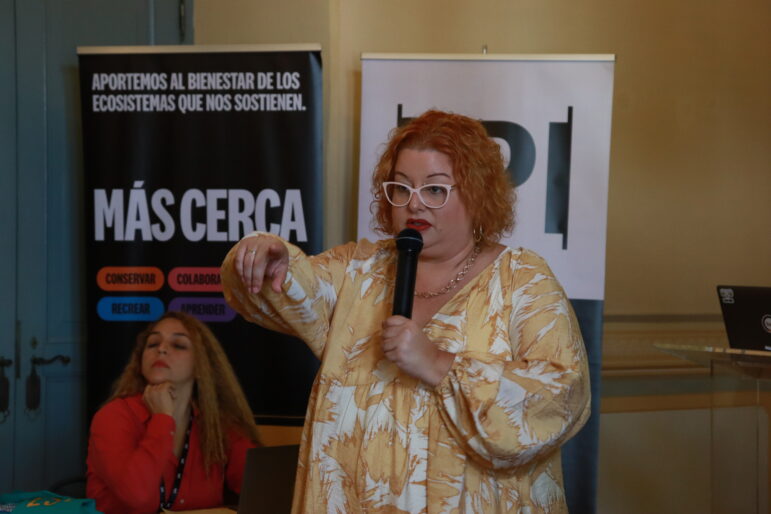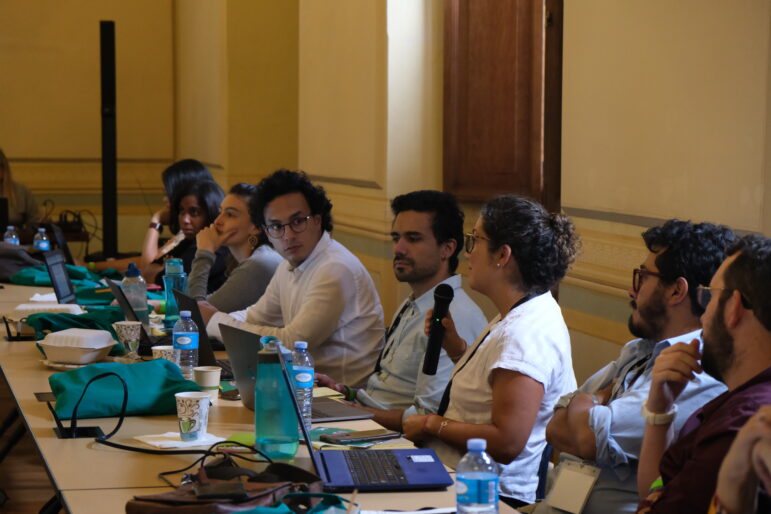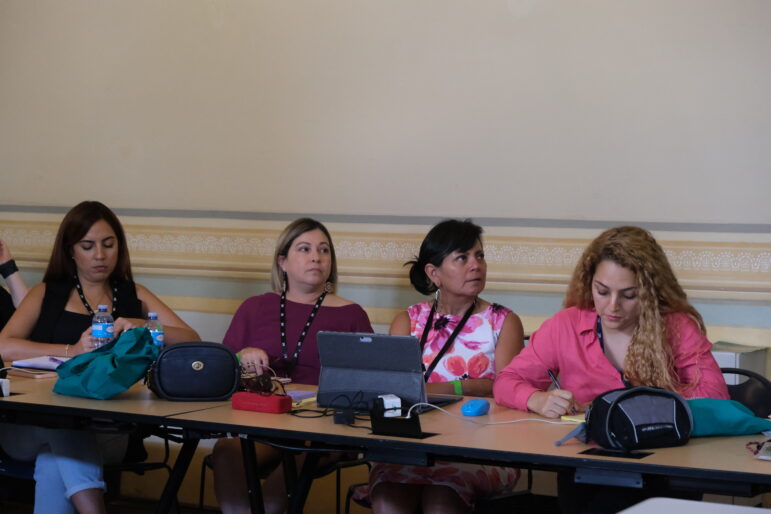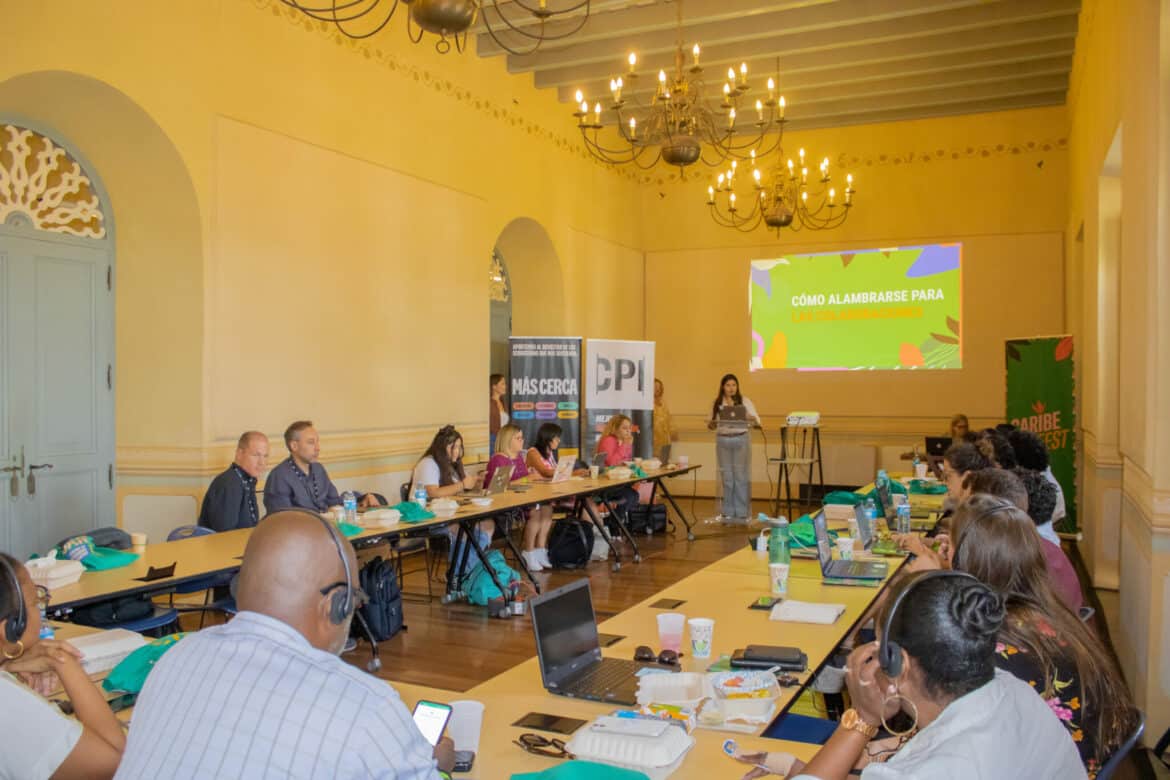The Center for Investigative Journalism (CPI, in Spanish) kicked-off the Caribe Fest today with a call from its Executive Director, Carla Minet, to promote collaborative investigations, particularly among journalists from the Caribbean, a region that is united by common problems and experiences such as the climate crisis, which is the central theme of this event that takes place through this Saturday in Old San Juan.
During the workshop “How to work collaborative investigations among media outlets,” Minet explained that collaborative writing is usually on topics that require a significant resources and experience. The CPI, based in Puerto Rico, has a long history of publishing investigative journalism in collaboration with media outlets in the United States, Latin America, and the Caribbean.
Minet’s experience in this type of collaborative projects has shown that they tend to be more efficient because it allows costs and resources to be distributed, there is greater transparency in the findings, and the validation of the information. “What networking journalism does is broadens the scope of investigations and the possibility of having a greater impact,” said the Puerto Rican journalist.
The Executive Director of the CPI explained that when this organization decides to work on a network-type project, it establishes clear confidentiality agreements and team communication methods that offer the greatest possible protection to the information that is shared. They also often do risk analysis to ensure the safety of journalists and sources.

Photo by Claudia Ortega | Center for Investigative Journalism
Minet mentioned that they use a vetting process that involves complete and accurate verification of information and review of sources to ensure the accuracy and completeness of the findings and conclusions.
Dana Kampa, a journalist from The BVI Beacon, British Virgin Islands, who participated in the workshop, told Minet that one of the main concerns that journalists may face in collaborative work is how to share raw data when it has to do with different audiences with different interests and needs.
“It’s difficult,” Minet acknowledged. The language, the units of measurement, the currency are categories that vary at the time of collecting and sharing the data in investigations between several media outlets. Those conversions, Minet said, make the process of sharing the data more complicated. She pointed out that CPI journalists collect, organize, and share information in the way that best benefits the parties.
While Minet was discussing the collaborations that the CPI has had with other media, Mariela Mejías, editor of Diario Libre, from the Dominican Republic, asked why traditional media tend to do less investigation or collaboration compared to smaller or independent media. In the opinion of the Director of the CPI, this responds to the fact that in “in newspapers, especially daily newspapers, the regular agenda almost always consumes all their resources,” but she thought that perhaps they will agree to work on collaborative projects if they receive a specific invitation.
Data-driven investigations
The arrival of sargassum in the Caribbean region and how to develop stories about this event is a concern shared by the Caribbean journalists who participated today in the “Data-driven Investigations workshop: where to find them?” presented during the Caribe Fest, by Giannina Segnini, director of the master’s in data journalism at Columbia University School of Journalism.
Although the journalists showed interest in possible investigations based on data related to water quality, the state of corals and other environmental issues, the topic of the accumulation and monitoring of sargassum was the one that received the greatest interest among the participants.

By Adriana I. Santa Porrata | Center for Investigative Journalism
Sargassum is a marine macroalgae that spreads across a large surface area in the North Atlantic. Recently, it blanketed an area that connects the Caribbean, the East of South America and part of the West of the continent of Africa.
Journalists also showed interest in how scientific data on this and other natural events and their impact on coastal communities can be collected and analyzed, so Segnini shared tools and resources to help Caribbean journalists access relevant information and monitor it in real time. This way, they will be able to improve their investigative skills and offer more accurate and detailed reports on environmental issues, said the professor.
Segnini suggested using NOAA’s Atlantic Oceanographic & Meteorological Laboratory tool to track the presence of sargassum and its effects on coastal communities. This platform has a specific database called “sargassum monitoring” that allows monitoring the location of sargassum in real time.
Meanwhile, Segnini explained that the Coast/Watch Ocean View tool, developed by the National Oceanic and Atmospheric Administration (NOAA), uses satellite technology to monitor several aspects in real time, such as hurricane activity, heat and ocean warming maps. This tool allows identifying critical areas and anticipates the arrival of these phenomena on the coasts.
Neither of those two technological tools allow analysis of the state of the corals, said the researcher, who acknowledged the challenges journalists have to develop stories based on data on this topic. It was precisely the editor of The BVI Beacon, Freeman Rogers, who said there is a lack of public knowledge about the state of corals due to limited data on this matter.
However, Segnini pointed out that there are tools like Deep Sea Coral & Sponge, which, at the very least, offer annual reports on the state of corals worldwide. In addition, it has a georeferential tool that allows visualizing the location of the corals. Corals are marine animals that exist as colonies made up of small individual polyps, according to NOAA. A coral reef exists when the base of an underwater habitat is formed by corals.

Photo by Adriana I. Santa Porrata | Center for Investigative Journalism
In addition, Segnini suggested the use of Google Earth to organize information related to climate changes and combine it with scientific data as to how they are affected. Data can be downloaded from the tools and added to Google Earth for research, she said.
The data journalism professor also noted that the Global Water Forum page provides data and indicators on the amount of water available and its accessibility, as well as a database on international water use regulations. She also mentioned Aquastat, a United Nations instrument, as one relevant to issues related to this vital resource.
Another handy tool for journalists to develop stories about the coasts can be the Copernicus Marine Data Store, which allows monitoring of ocean warming. The information found in this tool can be exported and explored, which makes it possible to pin-point critical places and carry out investigations.
Segnini also recommended the Global Forest Watch Map, which was originally used to track deforestation, but can now be useful for monitoring biodiversity, climate, fire records, among others. This tool uses satellite and geocentric technology, and its information can also be exported and taken to Google Earth for further analysis. She also discussed satellite image tools such as Sentinel Hub and Zoom.Earth, which allow real time monitoring of environmental conditions.
The experienced data journalist recommended that journalists connect with nonprofit Global Investigative Journalism Network, which supports and produces investigative journalism. In addition, it offers courses on how to use tools to carry out investigative journalism.
During the workshop, Bloomberg Línea journalist Mary Triny Zea Cornejo gave an example of how she used Global Fishing Watch to track illegal fishing records in Panama.
In her presentation, Segnini highlighted the importance of working in a multidisciplinary way on issues such as climate change, of not doing everything on our own and of working as a team. In addition, she gave an overview of web and deep web search techniques, such as using advanced operators in Google and searching via inUrl.
The Caribe Fest is hosting journalists from Barbados, Colombia, Costa Rica, Cuba, Guadeloupe, Haiti, the United States Virgin Islands, Mexico, Panama, and Jamaica. The event continues this Friday with the keynote address “Main challenges of the global climate crisis for the Caribbean,” delivered by Rueanna Haynes, who is a specialist in international climate law and governance. Haynes has more than a decade of experience in the United Nations climate processes and is a speaker at TEDx 2020. The public can participate in several of these events.
The event is sponsored by the CPI, an organization created as an instrument to promote and defend the right of access to information and has played a critical role in the investigation and dissemination of events and information that affect Puerto Rico.





